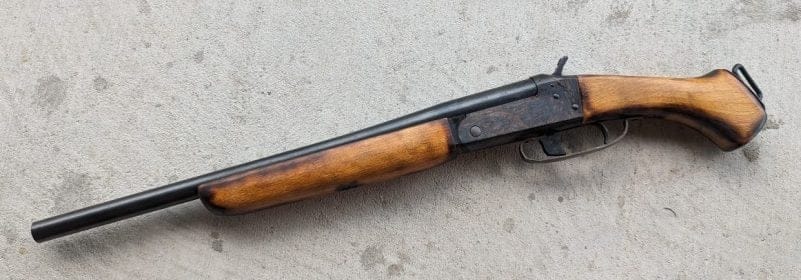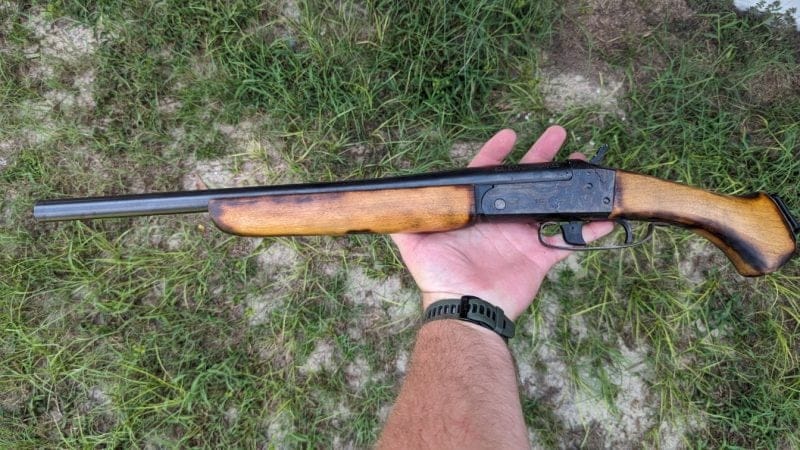Sometimes, a gun gets known more by its nickname than anything else. Hitler’s Buzzsaw, Tommy Gun, boomstick, and many other nicknames propel a gun into the spotlight. One such term from our Italian friends is the “Lupara”. Lupara translates into ‘for the wolf.’ That’s a pretty good indication of the Lupara’s original use. It was for hunters to track down and kill wolves who might be terrorizing a farm or village.
The concept of the Lupara stuck around, and it slowly seeped into other avenues. This includes use in World War 2 and, of course, its place in organized crime. The Lupara evolved into a part of pop culture thanks to movies, and it came to America by way of Italy. Although the Italians didn’t invent the idea, they popularized the name.
What’s a Lupara?
A Lupara is typically a twelve-gauge shotgun with a break-open action. These guns are single or double-barrel shotguns and, while pop culture has popularized them as double barrels, it’s likely the majority were single-barrel guns. This assumption is made knowing single-barrel guns are always cheaper than double-barrel guns, and cheap is typically what you look for in a gun you’re taking a hacksaw to.

Additionally, older double barrels can be finicky about being cut. Some cheaper older guns do not have the barrels connected for the entirety of their length. Instead, they are more or less brazed in sections along the barrel. Cutting between these sections could weaken the integrity of the entire gun.
My biggest piece of evidence as to why single-barrel guns were more commonly used comes from the fact that we have a confirmed Mobster’s Lupara. Joe Bonanno owned a Lupara in the form of a single-shot shotgun.
Stocked or Not?
These guns have been seen with and without stocks. I’d imagine, when a farmer gets a Lupara, he prefers the stocked model. It certainly makes aiming at wolves easier. The trimmer front barrel makes it easier to maneuver in thickets. The lack of a stock makes it tougher to handle but also concealable.
The most popular depiction of the Lupara comes from The Godfather Part 2. Michael Corleone is hiding in Italy and his bodyguards carry short double-barrel shotguns that still wear their stocks alongside simple leather slings. In 1890, the Police Chief of New Orleans was murdered. A pile of sawn-off shotguns was found at the crime scene. One had a homemade folding stock while another used a hook to brace the gun against the arm.

The history of these guns goes back to 1890. Sheepherders likely preferred the Lupara because they were easy to handle and could take down a wolf when loaded with buckshot. A shotgun with its choke cut-off throws a wide pattern, and a wolf would likely be moving. A load of buckshot spreading rapidly likely made it much easier to hit the running wolf.
The popularity of these guns is likely what led them to be used by criminals. They were common and fairly cheap, two traits we often see in criminal guns. If you cut the stock off, we get a cheap, common, and now concealable gun. They remained common enough that mafiosos used them against Mussolini’s forces. Later, they ended up in the hands of Italian partisans during World War 2.
My ‘Lupara’
I developed a great interest in Luparas after I purchased one. Well, it’s not exactly a real one made by the hands of an Italian sheep farmer, but a close approximation. This gun is a Bubba’ed Stevens 9478. It’s a single barrel 20 gauge. Our gunsmith in training took the barrel down to 18.5 inches and trimmed the stock into a pistol grip.
More than that, he removed the original trigger guard and replaced it with one of his own. This new trigger guard encapsulates the trigger as well as the barrel release. This makes it easier to open the barrel with a single hand. The rear pistol grip was surprisingly well done with an added sling swivel. If I was a mafioso with a slick suit, I could pack this under a jacket.

The gun has a manually cocked hammer with an extractor but no ejector. It’s very simple. It looks like the previous owner even tried to attach a front sight, but it has since fallen off. This isn’t much of a gun that you can aim. It’s really more of a point-and-shoot affair. Admittedly, the previous owner hacked the gun up. However, it took a rather plain 20 gauge shotgun and made it into something a little more interesting.
How does one of these guns handle, though? That’s the real question. To find out, I grabbed some buckshot and birdshot and went to the range.
The Lupara in Action
I’m no stranger to recoil, but I do think the 20 gauge is a great choice for this type of gun. It’s still quite powerful, but won’t beat you up too much. This is the only 20 gauge I own at this point and I was a little surprised at how hard it was to find proper defensive buckshot. Not wanting to order and wait, I settled for some basic Winchester Super X 3-inch buckshot and Fioochi birdshot.

I warmed up with the Fioochi and found the recoil stout, but the shotgun was pointable. My targets were clay pigeons placed on the berm and, at ten yards, I picked them off with ease. It became a fun game to see how fast I could shoot, reload, and shoot again. It never took less than several seconds. This would be the type of weapon you’d fire and, if you missed the wolf, you’d hope the noise scared him off.
Buckshot Promises
I loaded up that three-inch load of Number 3 buckshot and let it rip. Recoil went from stout to, “oh hell, hold on” pretty quickly. This Lupara is not uncontrollable, and the super light single barrel gun recoils like a 12 gauge Shockwave. You can still aim the gun and fire it from eye level, but hold onto it.
At 15 yards, the pellets essentially spread from one side of an IPSC target to the other. That’s about 18 inches. It’s no Flitecontrol; but, if you needed more spread to hit a moving wolf, then this would do it. I think the 20 gauge Winchester Defender load would be a hell of a lot better. At the very least, it would have much less recoil.

Would I use the weapon for home defense? No, not likely. The single-shot nature and lack of a stock make it more of a novelty. With that said, it is very small and light. It would make a good pest gun and an exceptional snake remover. It could be an adequate outdoor gun on an ATV or strapped to a pack. It’d keep the chicken coop clear pretty well.
The Lupara was a weapon of its time and situation. I don’t have a wolf problem by any means, but that doesn’t mean I can’t appreciate a light and handy shotgun.

